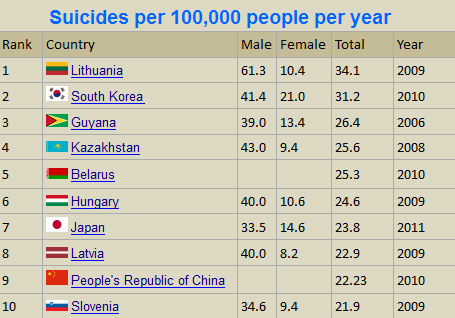
THE VOICE OF INTERNATIONAL LITHUANIA
|
VilNews has its own Google archive! Type a word in the above search box to find any article.
You can also follow us on Facebook. We have two different pages. Click to open and join.
|

Latest statistics from the World Health Organization show that Lithuania again is on top when it comes to suicides – with 61,3 men 10,4 women per 100,000 inhabitants deciding to end their lives this sad way – annually.
Dainius Puras, a Lithuanian psychiatrist, explains how it is the uncertainty and unpredictability of the economic situation that have such a detrimental effect: "People don't like change,” he says, referring to Lithuania’s 20-year period of dramatic social and economic change since the fall of the Soviet Union in 1991”.
He describes the reaction to freedom in 1989: "Many people could not manage to cope with this change, with this huge societal stress . . . [they] regressed to destructive or self-destructive behaviour." The stress, he says, prompted an unprecedented crisis of mortality, one that still exists. In Lithuania, with a population of just three million, 5,000 people die every year because of "external causes" - suicide, homicide, violence. He describes it as an epidemic.
Lithuania - a prophetic microcosm of the global crisis?
Puras sees Lithuania's experience as a prophetic microcosm of the global crisis: a society undergoing enormous stress because of the effects of a toxic system, culminating in an “explosion" in the form of a financial crisis. He also points out a strange trend: the more severe the threat to human life, the better societies and individuals seem to fare in their mental health. "History shows that when it is a real crisis like war, or when people are starving, there is a huge decrease in mental health problems, including suicide. During the war you have to survive physically; existential problems are not so important. Suicide is mainly the price we pay for civilisation."
Figures for the UK support his theory - during the First World War, the suicide rate dropped to 8.5 per 100,000. It then leapt to 13.5 in the interwar years, and fell again during the Second World War to 9.2. Immediate, life-threatening crisis, Puras says, creates a sense of purpose: there's not as much time to worry about yourself.
( From an article in “New Statesman”, by Sophie Elmhirst)
Lithuanian Suicide Hotline
Youth Psychological Aid Centre -Vilnius Youth Line
Jaunimo psichologinés paramos centras
Rasu g.20, LT-11351 VILNIUS
Hotline: 8-800 2 8888
Website: jppc.lt
Hours: Mon, Tues, Wed, Thurs, Fri, Sat, Sun: 16:00 - 07:00
Suicides per 100,000 people per year
The following is a list of suicide rates by country according to data from the World Health Organization, in which a country's rank is determined by its total rate deaths officially recorded as suicides in the most recent available year, last updated in 2011.
Male and female suicide rates are out of total male population and total female population, respectively (i.e. total number of male suicides divided by total male population). The total rate of suicides is based on the total number of suicides divided by the total population rather than merely the average of the male and female suicide rates, because the gender ratio in most countries is not 1:1. Year refers to the most recent year that data was available for a particular country.

Other articles:
http://www.elnet.lt/psychoanalysis/psychoanalysis/Vilmos2.htm
http://eurpub.oxfordjournals.org/content/10/2/101.full.pdf
- Bookmark :
- Digg
- del.icio.us
- Stumbleupon
- Redit it
VilNews e-magazine is published in Vilnius, Lithuania. Editor-in-Chief: Mr. Aage Myhre. Inquires to the editors: editor@VilNews.com.
Code of Ethics: See Section 2 – about VilNews. VilNews is not responsible for content on external links/web pages.
HOW TO ADVERTISE IN VILNEWS.
All content is copyrighted © 2011. UAB ‘VilNews’.

 Click on the buttons to open and read each of VilNews' 18 sub-sections
Click on the buttons to open and read each of VilNews' 18 sub-sections 


